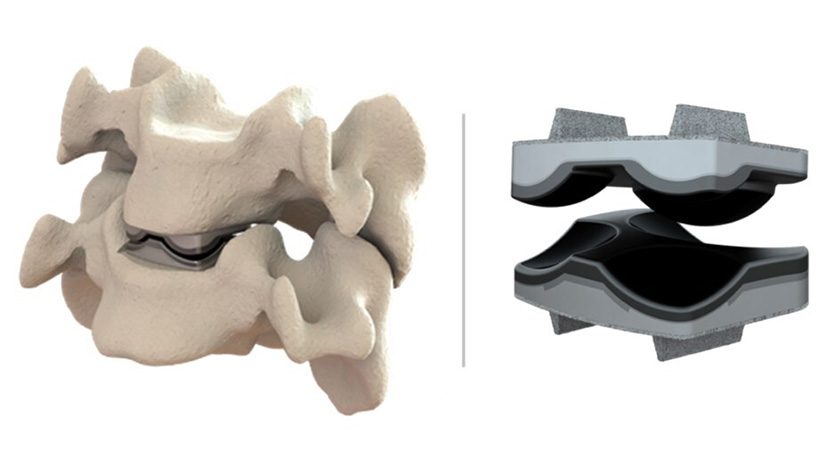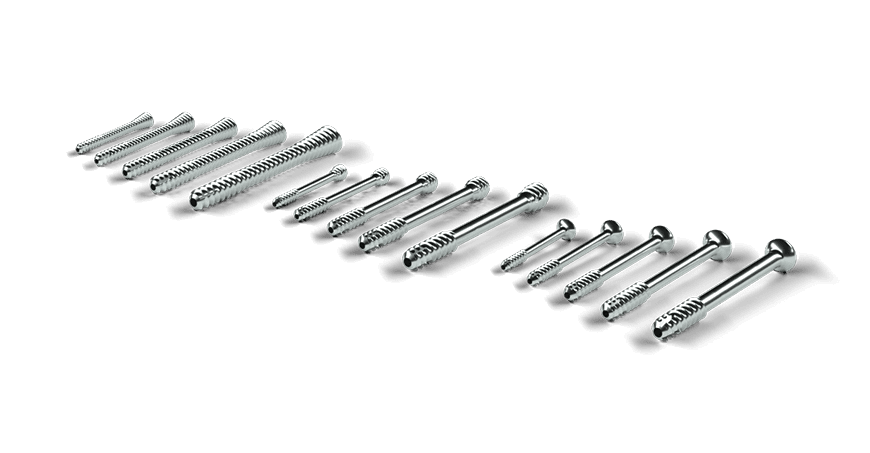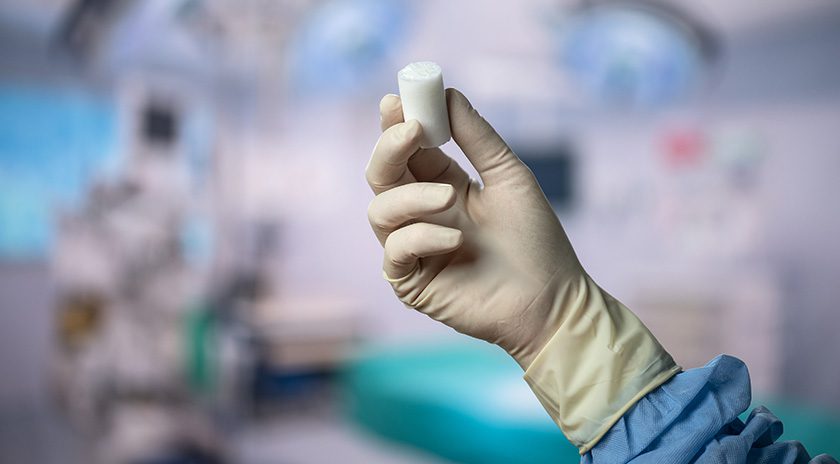

 Copy to clipboard
Copy to clipboard 
When Dymicron received FDA Investigational Device Exemption (IDE) approval to launch a pivotal trial of its Triadyme-C cervical artificial disc in July, the company took an important step toward entering the competitive U.S. spine market.
Dymicron was founded in 1997 with the goal of developing a next-generation cervical total disc replacement and has worked for decades to perfect its design and material.
The Orem, Utah-based company’s Triadyme-C cervical artificial disc features bearing surfaces made from Adymite, a proprietary polycrystalline diamond material. Adymite was developed specifically for high-stress, load-bearing environments and is engineered to dramatically reduce wear debris generation compared to conventional implant materials. Furthermore, Triadyme-C’s Tri-Lobe design mimics the natural kinematics and motion of a normal intervertebral disc and enforces the proper translation and rotation of the spine during movement.
Triadyme-C carries a CE Mark and is sold in Europe and Latin America, and the company continues to expand its OUS presence, said David Harding, Ph.D., Director of Materials Engineering. Still, Dymicron is strategically focused on entering the U.S. spine market.
The first implantations of Dymicron’s prospective, multicenter trial in the U.S. are expected to occur before the end of 2025. Using historical controls, the trial will compare the safety and effectiveness of the Triadyme-C disc against anterior cervical discectomy and fusion (ACDF) surgery in treating symptomatic cervical disc disease (SCDD). Dymicron hopes to use the data collected from this trial to support the company’s FDA premarket approval (PMA) submission.
Here, Dr. Harding shares insights about what it’s like to bring a highly complex product to market in the U.S. while simultaneously educating regulators, competitors, and potential customers about the role of polycrystalline diamond in orthopedic implants.
What technical problems is Dymicron trying to solve?
Dr. Harding: We know that fusion is a good, reproducible procedure, but it increases motion in other vertebral segments. That additional motion pushes the disc beyond its normal range, which accelerates the degeneration in adjacent segments. People are looking at motion preservation to decrease the number of secondary surgeries that patients need due to accelerated degeneration of adjacent segments.
However, when you put in an artificial disc, you face questions of longevity that you don’t with fusion. Right now, one of the biggest concerns in the cervical disc space is osteolysis from wear debris. Heterotopic ossification leading to eventual fusion is another concern that people have generally about arthroplasty. These two challenges are specifically what Dymicron set out to address with our cervical implant.
As the only diamond product in the implant market, what are some of the pros of being unique?
Dr. Harding: Other artificial disc manufacturers have to solve the huge problem of how to prevent and manage up to 40 years of wear without re-operation. The biggest concerns in the industry are the wear particles released from the implants and the impacts they cause. That’s not really an issue for us.
We have such an amazing material that we don’t have to worry about wear debris. Instead, we have the luxury of focusing on a different question: how do we best replicate the natural motion of the spine? We approach it from the perspective that sliding geometry allows for the most natural motion. Our three-lobe design is inherently energetically stable. You can move the disc away from the center, and it returns to the center. No other hard-on-hard disc has this trait.
Our disc also exhibits pseudoelasticity, despite being made of diamond. When you shake it, the disc will move like Jello. Because the disc is self-centering, the farther it moves off-center, the stiffer the motion becomes, which is what the natural disc does as well.
What are the downsides of being unique in the marketplace?
Dr. Harding: FDA’s standardized testing has been a challenge due to the material’s unique properties. The wear test posed no problem, and in fact, our results showed remarkably little wear, which makes sense. However, the next test was to characterize our wear particles, and that became complicated. The lab notified us that they were unable to find any wear particles, even though we knew some wear had taken place.
We learned that, when diamond wears against diamond, it converts that diamond into amorphous carbon, similar to the activated [charcoal] that doctors treat people with if they have poisoning. So, where other implants produce microplastics that can cause osteolysis, we produce free carbon, which is benign in the body. It’s a complicated message to convey.
What does the future hold for Dymicron?
Dr. Harding: We think our material can be applied to many different joints, including the thumb and fingers. What’s more, diamond is a very biocompatible material with good electrical properties, so there’s a lot of potential even beyond joints.
As a small company, we’re experiencing the typical growing pains where orders from Europe are coming in and we’re pulling some late nights and weekends just to keep up. The idea that we will have to divert products and much of our time and resources to support our clinical trial is a bit daunting. That will limit the amount and scope of new research we can do for the next five years while the trial is active. But it’s also exciting to be getting closer to market in the U.S.
When Dymicron received FDA Investigational Device Exemption (IDE) approval to launch a pivotal trial of its Triadyme-C cervical artificial disc in July, the company took an important step toward entering the competitive U.S. spine market.
Dymicron was founded in 1997 with the goal of developing a next-generation cervical total disc...
When Dymicron received FDA Investigational Device Exemption (IDE) approval to launch a pivotal trial of its Triadyme-C cervical artificial disc in July, the company took an important step toward entering the competitive U.S. spine market.
Dymicron was founded in 1997 with the goal of developing a next-generation cervical total disc replacement and has worked for decades to perfect its design and material.
The Orem, Utah-based company’s Triadyme-C cervical artificial disc features bearing surfaces made from Adymite, a proprietary polycrystalline diamond material. Adymite was developed specifically for high-stress, load-bearing environments and is engineered to dramatically reduce wear debris generation compared to conventional implant materials. Furthermore, Triadyme-C’s Tri-Lobe design mimics the natural kinematics and motion of a normal intervertebral disc and enforces the proper translation and rotation of the spine during movement.
Triadyme-C carries a CE Mark and is sold in Europe and Latin America, and the company continues to expand its OUS presence, said David Harding, Ph.D., Director of Materials Engineering. Still, Dymicron is strategically focused on entering the U.S. spine market.
The first implantations of Dymicron’s prospective, multicenter trial in the U.S. are expected to occur before the end of 2025. Using historical controls, the trial will compare the safety and effectiveness of the Triadyme-C disc against anterior cervical discectomy and fusion (ACDF) surgery in treating symptomatic cervical disc disease (SCDD). Dymicron hopes to use the data collected from this trial to support the company’s FDA premarket approval (PMA) submission.
Here, Dr. Harding shares insights about what it’s like to bring a highly complex product to market in the U.S. while simultaneously educating regulators, competitors, and potential customers about the role of polycrystalline diamond in orthopedic implants.
What technical problems is Dymicron trying to solve?
Dr. Harding: We know that fusion is a good, reproducible procedure, but it increases motion in other vertebral segments. That additional motion pushes the disc beyond its normal range, which accelerates the degeneration in adjacent segments. People are looking at motion preservation to decrease the number of secondary surgeries that patients need due to accelerated degeneration of adjacent segments.
However, when you put in an artificial disc, you face questions of longevity that you don’t with fusion. Right now, one of the biggest concerns in the cervical disc space is osteolysis from wear debris. Heterotopic ossification leading to eventual fusion is another concern that people have generally about arthroplasty. These two challenges are specifically what Dymicron set out to address with our cervical implant.
As the only diamond product in the implant market, what are some of the pros of being unique?
Dr. Harding: Other artificial disc manufacturers have to solve the huge problem of how to prevent and manage up to 40 years of wear without re-operation. The biggest concerns in the industry are the wear particles released from the implants and the impacts they cause. That’s not really an issue for us.
We have such an amazing material that we don’t have to worry about wear debris. Instead, we have the luxury of focusing on a different question: how do we best replicate the natural motion of the spine? We approach it from the perspective that sliding geometry allows for the most natural motion. Our three-lobe design is inherently energetically stable. You can move the disc away from the center, and it returns to the center. No other hard-on-hard disc has this trait.
Our disc also exhibits pseudoelasticity, despite being made of diamond. When you shake it, the disc will move like Jello. Because the disc is self-centering, the farther it moves off-center, the stiffer the motion becomes, which is what the natural disc does as well.
What are the downsides of being unique in the marketplace?
Dr. Harding: FDA’s standardized testing has been a challenge due to the material’s unique properties. The wear test posed no problem, and in fact, our results showed remarkably little wear, which makes sense. However, the next test was to characterize our wear particles, and that became complicated. The lab notified us that they were unable to find any wear particles, even though we knew some wear had taken place.
We learned that, when diamond wears against diamond, it converts that diamond into amorphous carbon, similar to the activated [charcoal] that doctors treat people with if they have poisoning. So, where other implants produce microplastics that can cause osteolysis, we produce free carbon, which is benign in the body. It’s a complicated message to convey.
What does the future hold for Dymicron?
Dr. Harding: We think our material can be applied to many different joints, including the thumb and fingers. What’s more, diamond is a very biocompatible material with good electrical properties, so there’s a lot of potential even beyond joints.
As a small company, we’re experiencing the typical growing pains where orders from Europe are coming in and we’re pulling some late nights and weekends just to keep up. The idea that we will have to divert products and much of our time and resources to support our clinical trial is a bit daunting. That will limit the amount and scope of new research we can do for the next five years while the trial is active. But it’s also exciting to be getting closer to market in the U.S.

You’ve reached your limit.
We’re glad you’re finding value in our content — and we’d love for you to keep going.
Subscribe now for unlimited access to orthopedic business intelligence.
DL
Darcy Lewis Darcy Lewis is an ORTHOWORLD Contributing Editor






